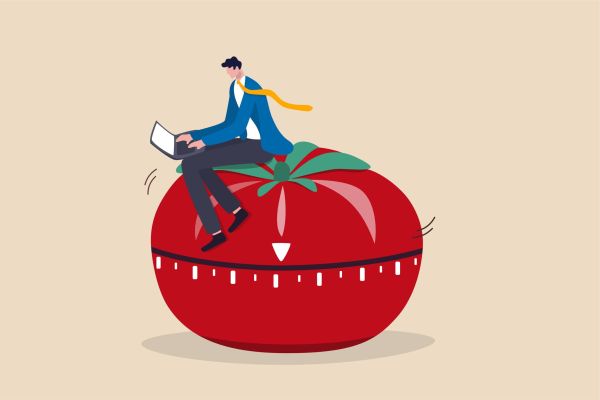Introduction
In the ever-evolving landscape of productivity methodologies, the Pomodoro Technique stands out as a time-tested and highly effective approach. Conceived by Francesco Cirillo in the late 1980s, this technique has garnered widespread acclaim for its simplicity and ability to enhance focus and productivity. In this comprehensive exploration, we delve into the principles, benefits, and practical applications of the Pomodoro Technique, illustrating how it can revolutionize the way individuals approach their work for better results.
Understanding the Pomodoro Technique
Mastering time management is a crucial skill in today’s fast-paced world, and the Pomodoro Technique offers a structured approach to boost productivity.
Here’s a breakdown of its key components:
1. Breaking Down the Basics
At its core, the Pomodoro Technique is a time management method that revolves around the concept of breaking work into intervals, traditionally 25 minutes in length, separated by short breaks. Each interval is referred to as a “Pomodoro,” named after the Italian word for tomato, inspired by the tomato-shaped kitchen timer used by Cirillo during university.
2. The Pomodoro Process in Action
The Pomodoro Technique is implemented in a cyclical fashion. A typical cycle involves the following steps:
- Choose a task you want to accomplish.
- Set the Pomodoro timer for 25 minutes.
- Work on the task until the timer rings.
- Take a short break (around 5 minutes) to rest and recharge.
- Repeat the cycle. After completing four Pomodoros, take a longer break of 15–30 minutes.
3. Adaptable to Individual Work Styles
One of the Pomodoro Technique’s strengths lies in its adaptability. While the standard Pomodoro duration is 25 minutes, individuals can tailor the intervals to suit their preferences and attention spans. The key is to strike a balance between focused work and rejuvenating breaks to sustain productivity throughout the day.
The Psychology Behind Pomodoro
Understanding the psychological mechanisms behind the Pomodoro Technique sheds light on why it’s so effective in boosting productivity. Here’s a closer look:
1. Avoiding Burnout with Regular Breaks
The short breaks interspersed between Pomodoros serve a crucial role in preventing burnout and sustaining productivity. Beyond providing a moment of rest, these breaks allow the mind to recharge and rejuvenate. By taking regular pauses, individuals can avoid the mental exhaustion that often accompanies prolonged periods of focused work. This practice contributes to maintaining a high level of performance over an extended period, ensuring sustainable productivity without sacrificing well-being.
2. Enhancing Time Perception and Focus
Breaking work into manageable intervals enhances time perception and focus, a key psychological aspect of the Pomodoro Technique. Each Pomodoro creates a defined boundary within which tasks must be completed, instilling a sense of urgency and commitment.

This structured approach to time management fosters increased focus and productivity during work sessions. Additionally, by adhering to the Pomodoro intervals, individuals develop a heightened awareness of their productivity cycles. This awareness empowers them to optimize their workflow, allocate time more efficiently, and achieve greater efficiency in completing tasks. Ultimately, the Pomodoro Technique not only improves time management skills but also cultivates a deeper understanding of one’s productivity patterns, leading to enhanced overall performance.
Unlocking the Benefits of Pomodoro
Discover the advantages of integrating the Pomodoro Technique into your workflow and daily routine:
1. Heightened Focus and Concentration
By implementing the Pomodoro Technique, individuals can experience heightened levels of focus and concentration. The structured nature of the technique minimizes distractions and external interruptions, allowing for deep work. During each Pomodoro session, individuals commit to a singular task, fostering a state of flow and intense concentration that facilitates efficient progress.
2. Mitigating Procrastination
Procrastination often arises from the overwhelming nature of tasks. The Pomodoro Technique addresses this challenge by breaking down tasks into manageable chunks. Instead of fixating on completing the entire task at once, individuals focus on making progress within each Pomodoro interval. This shift in perspective makes the work more approachable and manageable, helping to mitigate procrastination tendencies.
3. Increased Awareness of Time Usage
Regularly tracking and recording completed Pomodoros offers valuable insights into time usage. Individuals gain a clearer understanding of how much time is dedicated to specific tasks, enabling better time management and the identification of areas for improvement. This heightened awareness allows for more strategic allocation of time and resources, ultimately enhancing productivity and efficiency.
4. Encouraging Work–Life Balance
The Pomodoro Technique inherently promotes a healthy work–life balance by incorporating regular breaks into the workday. These short pauses not only prevent burnout but also contribute to overall well-being. By taking breaks and stepping away from work at regular intervals, individuals can recharge, refresh, and return to tasks with renewed focus and energy. This emphasis on balance fosters sustained productivity and prevents the negative effects of overwork in the long term.
Practical Tips for Implementing Pomodoro
Here are some actionable tips to help you effectively implement the Pomodoro Technique into your workflow:
1. Choose the Right Tools
While you can start with a simple timer, consider exploring dedicated apps and tools designed to enhance the Pomodoro experience. Whether it’s a desktop application or a mobile app, finding the right tool can streamline the process and cater to your preferences, ultimately maximizing the benefits of the technique.
2. Experiment with Pomodoro Durations
The traditional 25-minute Pomodoro interval may not be ideal for everyone. Experiment with different durations to find what works best for you. Shorter intervals may be suitable for highly focused tasks, while longer ones may be more appropriate for complex or creative endeavors. By adjusting the duration, you can tailor the technique to suit your attention span and the nature of your tasks.
3. Adapt Pomodoro to Task Types
Recognize that different tasks require different levels of concentration and effort. Adapt the Pomodoro Technique to accommodate the nature of your work. For example, shorter Pomodoros may be suitable for routine or administrative tasks, while longer intervals may be more effective for complex problem-solving. By customizing the technique to fit the specific demands of each task, you can optimize your productivity and efficiency.
4. Combine Pomodoro with Task Batching
Integrate Pomodoro sessions with task batching, a strategy where similar tasks are grouped together and tackled consecutively. This approach capitalizes on the momentum generated within each Pomodoro, maximizing efficiency and minimizing context-switching. By batching similar tasks together and aligning them with Pomodoro intervals, you can streamline your workflow and accomplish more in less time.

Overcoming Challenges and Fine-Tuning Pomodoro
Here are strategies to tackle common challenges and refine your Pomodoro practice:
1. Dealing with Interruptions
Interruptions are par for the course in a bustling work environment. The Pomodoro Technique offers a solution by encouraging individuals to jot down external distractions during a Pomodoro session and deal with them during the subsequent break. This allows you to maintain focus on your task at hand while acknowledging and addressing any interruptions efficiently.
2. Cultivating Discipline
Consistently implementing the Pomodoro Technique requires discipline, which is developed over time. Start by setting a realistic number of Pomodoros per day and gradually increase the intensity as the habit solidifies. By incrementally building up your Pomodoro sessions, you’ll cultivate the discipline needed to sustain productivity and focus throughout your workday.
3. Flexibility for Creative Tasks
While Pomodoro excels in enhancing focus for analytical work, creative endeavors may require a more flexible approach. Experiment with longer intervals or integrate Pomodoro cycles within a broader creative process to accommodate the unique demands of creative tasks. This adaptable application of the technique allows for a balance between structured productivity and the fluid, exploratory nature often required in artistic and innovative pursuits. By tailoring the Pomodoro Technique to fit your creative workflow, you can optimize your creative output while maintaining a sense of structure and productivity.
Real-World Applications: Pomodoro in Various Professions
Let’s explore how the Pomodoro Technique is applied across different professions to boost productivity and enhance performance.
1. Programming and Software Development
Pomodoro proves invaluable for software developers during coding sessions. The structured intervals align perfectly with the intense focus required for coding, while regular breaks prevent mental fatigue. By adhering to Pomodoro cycles, developers establish a rhythm that enhances concentration and creativity. This leads to more efficient coding sessions and ultimately improves the overall quality of code produced.
2. Writing and Content Creation
Writers and content creators turn to Pomodoro to combat writer’s block and stimulate creativity. The short, focused intervals provided by Pomodoro help alleviate the overwhelming nature of large writing tasks. Breaking the creative process into manageable segments fosters a steady flow of ideas and cultivates a sense of accomplishment after each Pomodoro session. This psychological boost propels writers and content creators through the writing process with increased productivity and reduced stress.
3. Study Sessions for Students
Students harness the power of Pomodoro for effective study sessions. Breaking study material into manageable intervals enhances retention and prevents exhaustion from prolonged study hours. By incorporating Pomodoro into their study routine, students maintain focus, optimize their learning experience, and create a structured environment conducive to efficient information absorption. This approach leads to enhanced academic performance and reduced study-related stress.
The Future of Pomodoro: Adapting to Evolving Work Environments
As work environments continue to evolve, with remote work becoming increasingly prevalent, the Pomodoro Technique remains a versatile and adaptive tool.
In conclusion, the Pomodoro Technique transcends its simplicity to become a profound catalyst for optimal productivity. By embracing the structured intervals, individuals unlock a pathway to heightened focus, increased efficiency, and a sustainable approach to work. As the demands of the professional landscape continue to intensify, the Pomodoro Technique stands as a beacon, guiding individuals toward a more productive and balanced work life.
Related Posts





